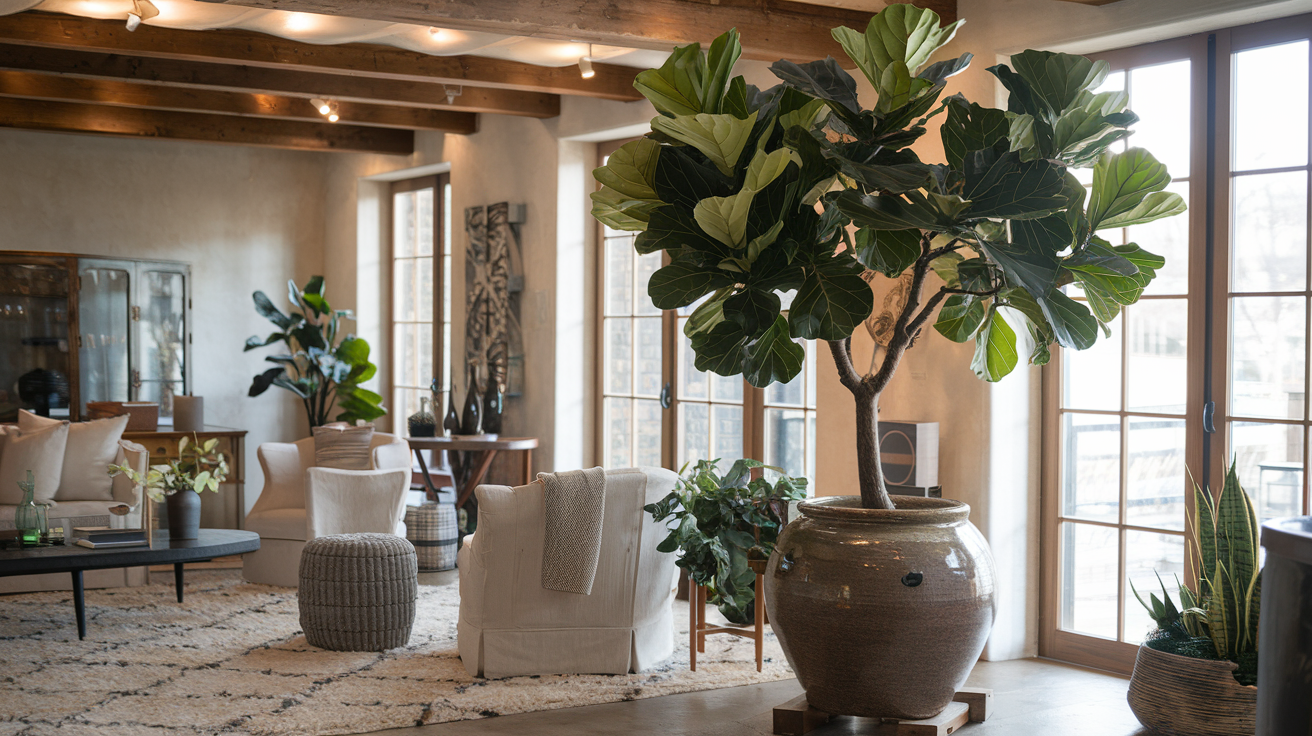There’s something undeniably impressive about a six-foot fiddle leaf fig commanding attention in a living room corner, its glossy leaves reaching toward the ceiling.
But here’s the reality many plant owners discover: large fiddle leaf figs require a completely different care approach than their smaller counterparts.
The stakes are higher—literally and figuratively—when you’re managing a mature specimen. Over my years working with these dramatic houseplants, I’ve learned that the transition from caring for a tabletop fiddle to maintaining a floor-standing giant requires adjusting nearly every aspect of your routine.
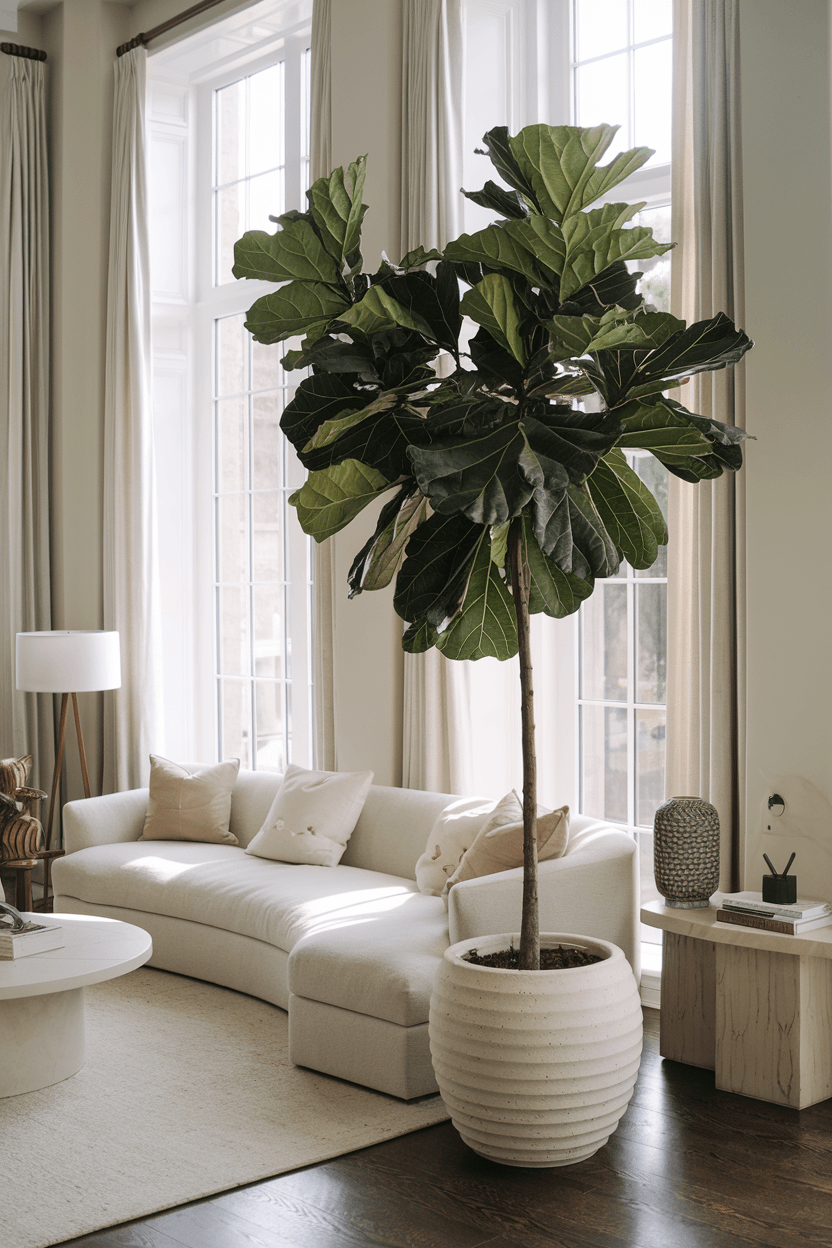
The good news? Once you understand what these large specimens need, they’re remarkably resilient.
This guide will walk you through the essential strategies that keep mature fiddle leaf figs thriving, from mastering the watering challenge to maintaining that enviable structure everyone photographs for Instagram.
Understanding the Unique Needs of Large Specimens
Large fiddle leaf figs operate differently than smaller plants in ways most care guides don’t address. When your tree stands four feet or taller, it’s no longer just about keeping leaves green—it’s about supporting significant vertical growth and managing substantially larger root systems.
I’ve found that the biggest mistake plant owners make is treating their mature fiddle exactly as they did when it was younger.
The root system of a large fiddle leaf fig can be extensive, often filling a 12-14 inch pot completely. This means water distribution becomes more complex, as you need to ensure moisture reaches all areas of the soil mass without creating waterlogged pockets.
The sheer volume of foliage also means these plants transpire more water, drawing moisture from the soil faster than their smaller relatives.
Here’s what changes with size: larger fiddles develop thicker bark on their trunks, making them more tolerant of environmental fluctuations but also slower to show stress signals.
By the time you notice drooping leaves or brown spots on a large specimen, the problem has often been developing for weeks.
This delayed response means prevention becomes exponentially more important than correction.
Pro tip: Check soil moisture at multiple depths. In large pots, the top three inches might be dry while six inches down remains saturated. I use a wooden dowel or moisture meter that reaches at least 8 inches deep to get an accurate reading before watering.
Mastering the Watering Balance
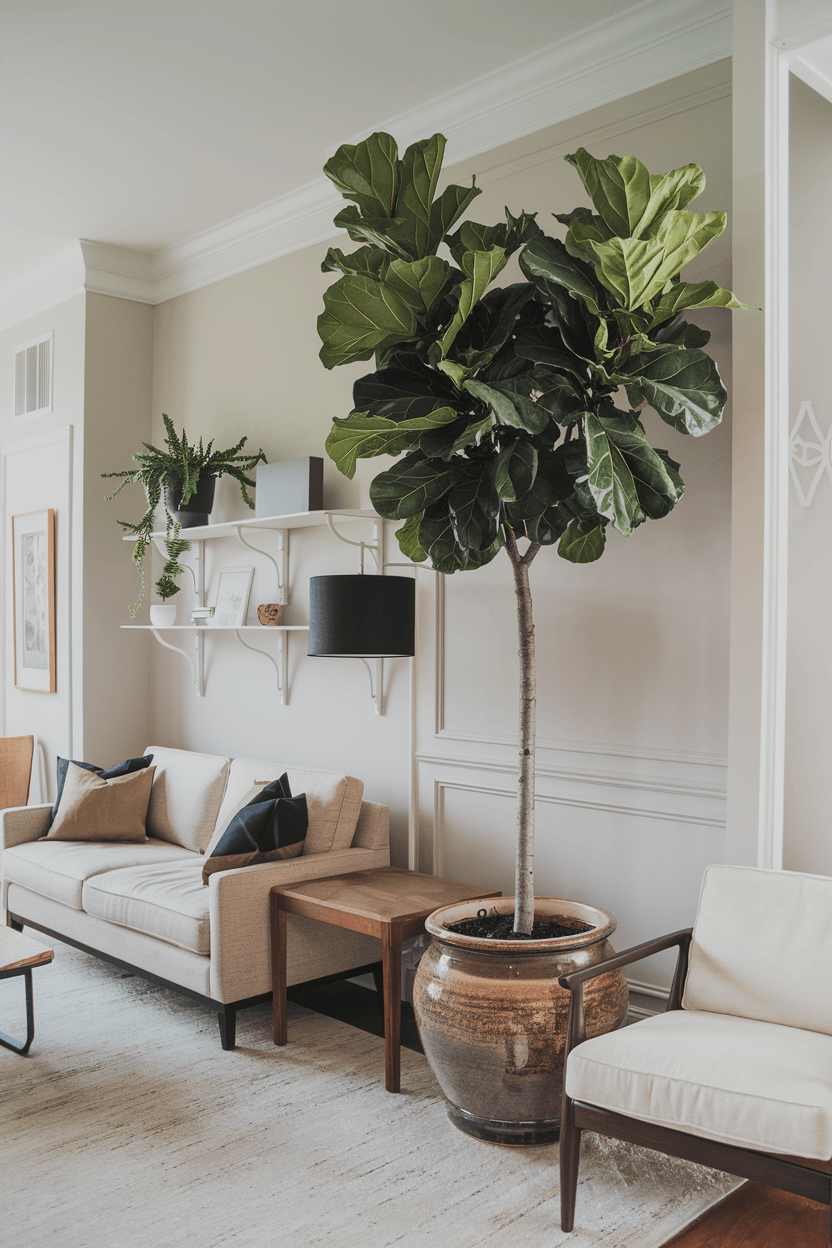
Watering a large fiddle leaf fig is where most care routines succeed or fail. The standard advice to “water when the top inch is dry” doesn’t scale effectively to large containers.
In my experience, the key is understanding that large pots create moisture gradients—different zones within the same container dry at different rates.
For a mature fiddle in a 14-inch pot or larger, I’ve developed a systematic approach: check moisture at the top (2-3 inches), middle (5-6 inches), and if possible, near the drainage holes.
Only water when the top half of the soil has dried out. This typically translates to watering every 7-10 days in most indoor environments, though seasonal variations matter significantly.
When you do water, thoroughness is critical. I water until I see streams flowing from drainage holes, which for a large pot means using 1-2 gallons of water per session. This ensures the entire root ball gets hydrated, not just the top layers.
Wait 30 minutes, then pour off any water remaining in the saucer—large fiddles are particularly susceptible to root rot when left sitting in water.
Temperature and light directly impact watering frequency. During winter months when growth slows and indoor heating reduces humidity, you might water every 10-14 days. In summer, especially if your fiddle sits near a south-facing window, you might need to water weekly.
Pay attention to the weight of the pot—a well-watered large fiddle feels noticeably heavier than one that needs watering.
Action step: Establish a checking routine rather than a watering schedule. I assess my large fiddles every 5 days, adjusting actual watering based on soil conditions rather than calendar dates.
Light Requirements and Strategic Positioning
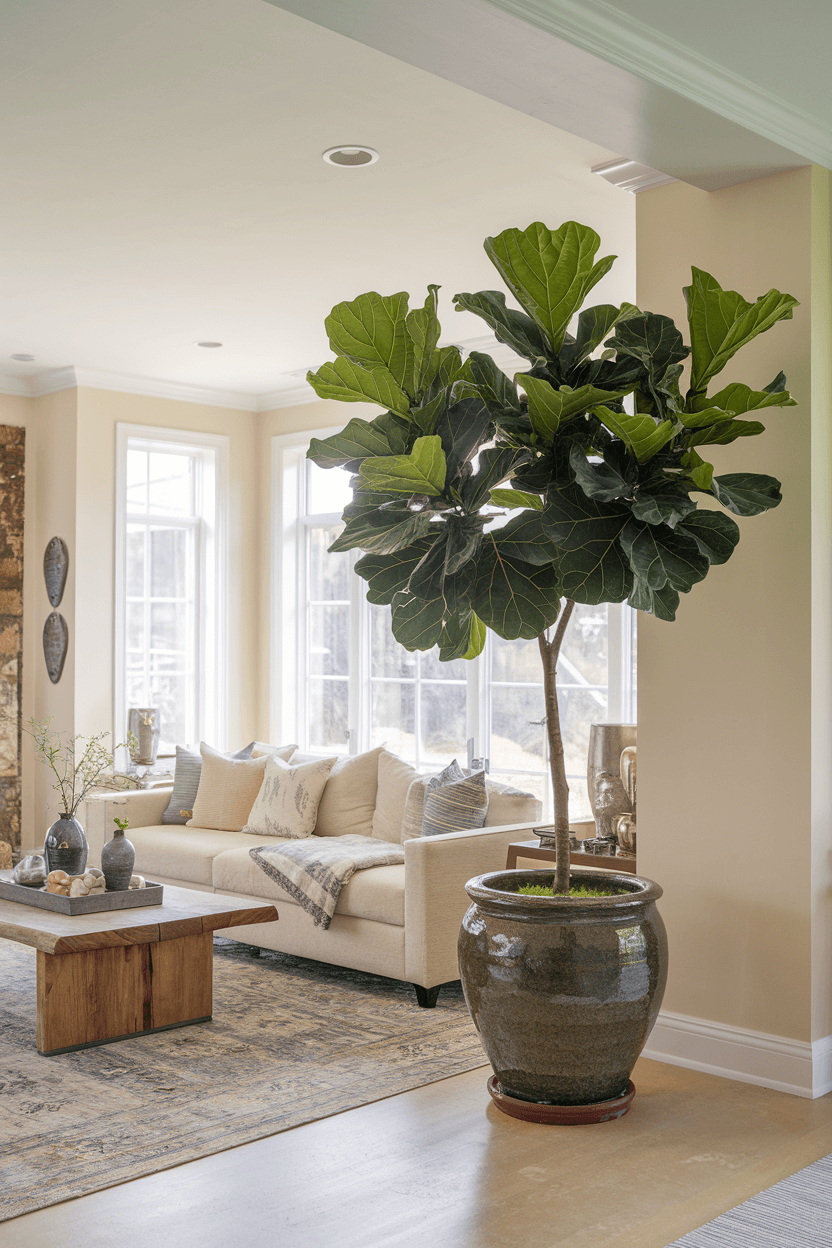
Positioning a large fiddle leaf fig requires thinking three-dimensionally. Unlike smaller plants you can easily rotate or relocate, a mature specimen becomes a semi-permanent fixture.
The challenge intensifies because large fiddles need substantial light—typically 6-8 hours of bright, indirect light daily—but their size makes them difficult to place optimally.
I’ve learned that the ideal spot for a large fiddle is 3-5 feet from a south or west-facing window, where it receives abundant filtered light without direct sun scorching the leaves. However, here’s the nuance: large fiddles can tolerate and even benefit from some direct morning sun, particularly on their lower leaves.
The top portion of the tree, which gets the most light naturally, should remain protected from intense afternoon rays.
One issue specific to large specimens is uneven light distribution. The top of your tree might receive excellent light while lower branches remain shaded by the upper canopy. This creates leggy growth patterns and leaf drop on lower branches. To combat this, rotate your fiddle 90 degrees every month if possible.
I realize this is challenging with a heavy, floor-standing plant, but even partial rotations help. If rotating is impossible, consider supplementing with a grow light positioned to illuminate the lower third of the plant.
Watch for light-related stress signals that manifest differently in large plants. Rather than universal yellowing, you’ll often see targeted problems: lower leaves dropping while upper growth thrives (insufficient light reaching bottom branches), or one side of the tree showing more vigorous growth than the other (uneven light distribution).
Structural Support and Maintenance Strategies
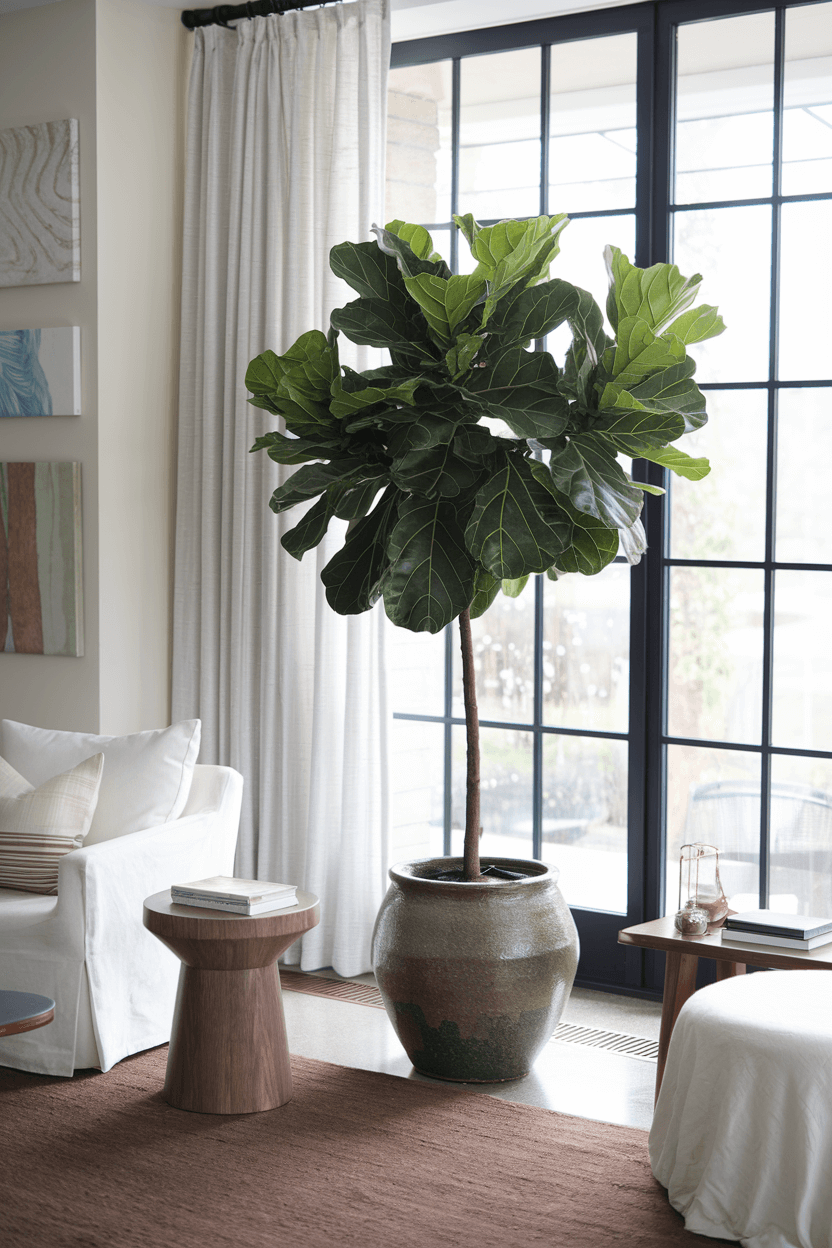
The vertical architecture of a large fiddle leaf fig demands ongoing structural attention. Trees over five feet tall often need staking to prevent toppling, especially in homes with pets or children.
I use bamboo stakes placed at the pot’s edge rather than driven through the root ball, connecting them to the trunk with soft plant ties at 12-inch intervals.
Pruning becomes both more important and more intimidating with large specimens. The goal is maintaining shape and encouraging branching at desired heights rather than just removing damaged leaves.
I typically prune in early spring when the plant enters its active growth phase. For large fiddles, focus on cutting back leggy branches by 3-6 inches, making cuts just above a node to encourage side shoots.
Leaf maintenance takes on new significance when you’re dealing with 50+ large leaves. Dust accumulation blocks photosynthesis, so I wipe leaves monthly with a damp cloth, working from the base of the leaf toward the tip to avoid damaging the delicate tissue.
This also provides an opportunity to inspect for pests, which can hide on the undersides of leaves on tall plants that aren’t frequently examined up close.
Expert insight: Large fiddles benefit from occasional “grooming sessions” where you remove any leaves showing more than 50% damage.
This directs energy toward healthy growth rather than attempting to sustain compromised foliage. The tree will look temporarily sparse but rebounds stronger.
Fertilization and Soil Health for Mature Trees
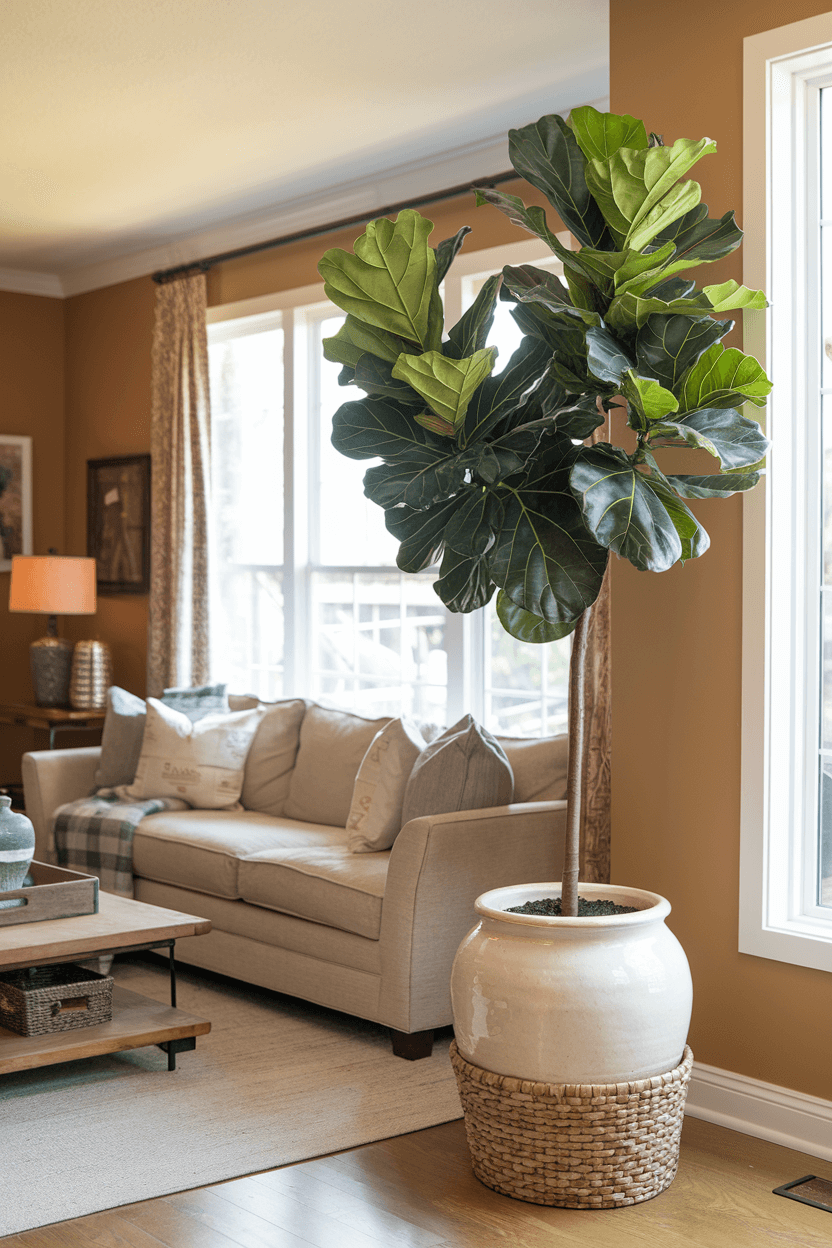
Large fiddle leaf figs have substantial nutritional needs that evolve as they mature. A tree with extensive foliage and an established root system requires consistent feeding during the growing season, but the approach differs from younger plants. I use a balanced liquid fertilizer diluted to half strength, applied every 2-3 weeks from March through September.
The soil composition matters significantly for large specimens. Over time, potting mix compacts and loses its ability to drain effectively, even without repotting.
For large fiddles I can’t easily repot, I top-dress annually—removing the top 2-3 inches of soil and replacing it with fresh potting mix enriched with compost.
This refreshes nutrients and improves surface drainage without the disruption of full repotting.
Repotting a large fiddle is a major undertaking best done every 2-3 years or when roots visibly circle the pot’s exterior. When the time comes, increase pot size by only 2 inches in diameter—oversized pots retain too much moisture and actually slow growth.
The process typically requires two people and careful maneuvering to avoid breaking branches.
Conclusion: The Long-Term Perspective
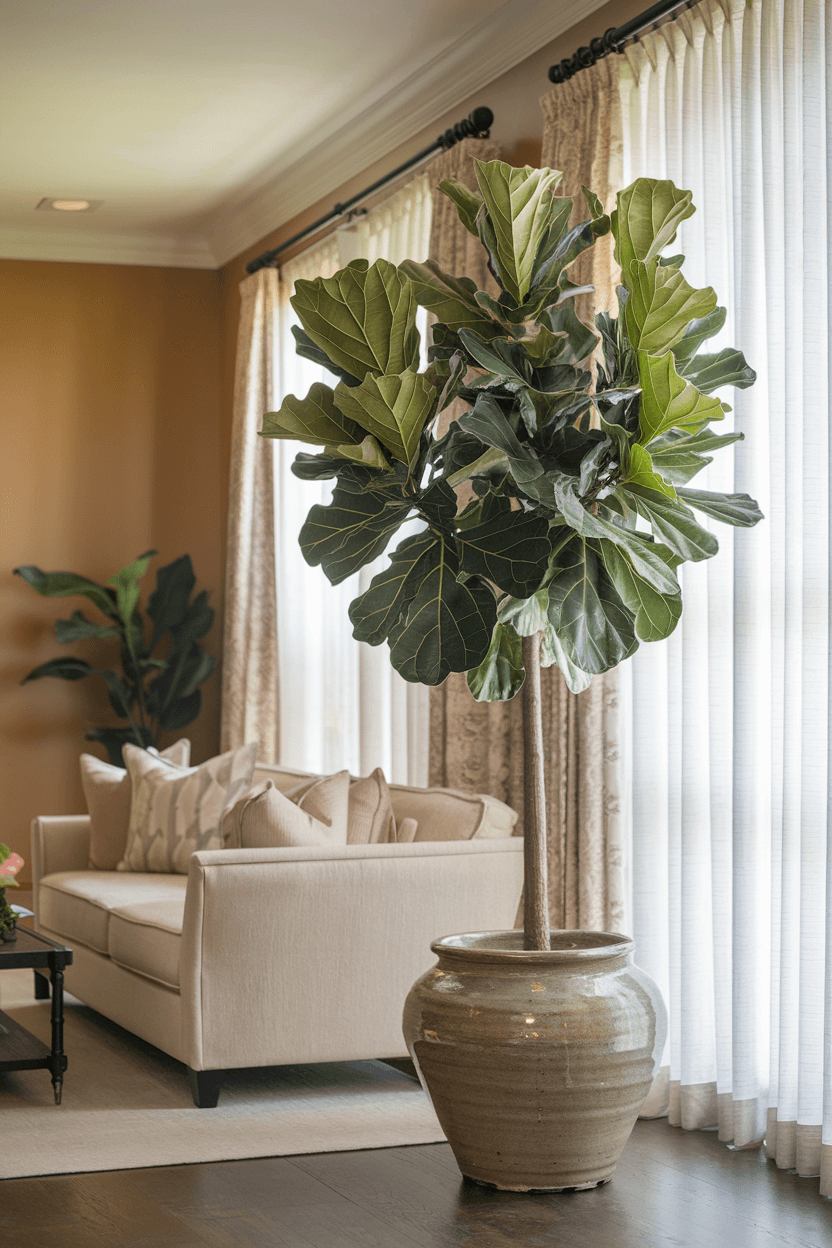
Caring for a large fiddle leaf fig is ultimately about developing observation skills and maintaining consistency. These impressive plants reward patience and attentiveness with years of dramatic presence in your space.
The specific techniques matter less than understanding the underlying principles: large specimens need thorough but infrequent watering, abundant light with strategic positioning, and proactive structural maintenance.
In my experience, the most successful large fiddle owners are those who treat their plant as a long-term project rather than expecting immediate results from care adjustments. Pay attention to seasonal patterns, respond to the specific signals your tree provides, and remember that size brings both impact and responsibility.
Your mature fiddle leaf fig isn’t just surviving in your space—with proper care, it’s making a bold, lasting statement.

